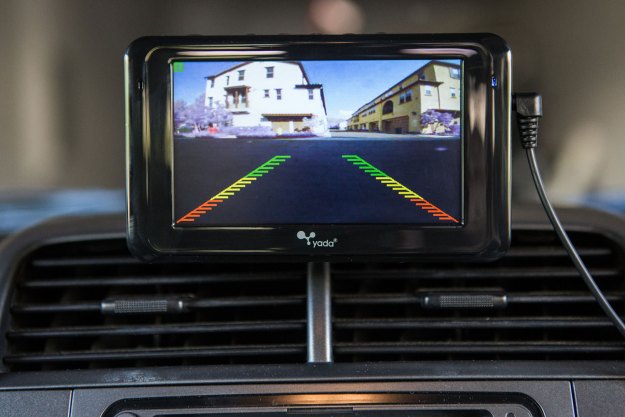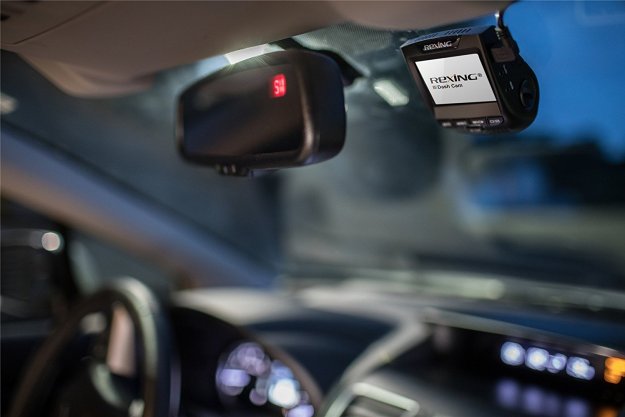
“The Yada Backup Camera may be one of the most simple and convenient safety updates to your car.”
- Great picture quality and viewing angles
- Clear visibility in low light
- Simple wireless connections
- Monitor allows for two cameras
- Only 12V charger for external camera
- Blank screen majority of time
“Never look back” may be a seemingly positive mantra spread throughout sites like Tumblr but it is dangerous advice in the car world. Rear visibility in your vehicle is such a serious issue that the NHSTA is requiring all new vehicles are equipped with a back up camera by 2018. The folks at Yada may already have you covered with every type of camera from the standard back-up cam to a baby monitor for your car. We wired in a couple Yada cameras to give you some added visibility into the aftermarket camera options and help you keep alert out on the road.
Installation
The Yada backup system with 5-inch monitor does require some basic installation and is certainly not something you can throw together in the Costco parking lot after purchase. For those with basic experience in wiring any automotive electrical items – like an aftermarket stereo – this shouldn’t be a problem. For those with no experience, there are some great tutorial videos on Yada’s website to help explain the steps to install the camera. I have a fair bit of experience and the installation process took me around 20-30 minutes on a 2005 Honda Element.
The kit includes all the necessary wiring, zip ties, and electrical connectors you will need. The camera unit simply attaches to the rear license plate with the help of 3M adhesive. The camera wire is fed through the rear tailgate or trunk lid to one of the tail lights. You use the power from the reverse light bulb to connect the power of the camera so it turns on once the car is put into reverse gear.
Features
Once installation is complete, the 5-inch monitor adheres to the dash or windshield with a suction cup mount and should be powered on when the car starts (it may be continuously powered depending on what type of 12V power source you use). Camera 1 will default to the backup camera and display when in reverse. The kit also includes wiring to hardwire the display into your car for a more permanent solution beyond the standard 12V plug. Upon initial installation, our camera did not display but it was discovered that the power connection was too loose to turn on the camera. After fixing the installation issue, we saw the camera display without problems.
The ease of setup with the wireless camera help to give Yada a leg up on the competition
The 5-inch display unit itself has physical buttons on top to power on, change channel to different cameras, turn on/off “Parking Aid” lines, and bring up the menu. Within the menu you only have basic features such as pairing a second camera or modifying the brightness and contrast. The “Parking Aid” lines are typical on OEM backup camera systems and display green, yellow, and red dashes on the screen to help line up parking spots and gauge distance to obstacles. If a second camera is not paired and you are not in reverse, then the screen will remain blank while driving.
Backup Camera Display
The display quality on the Yada Backup system is clearer than the majority of OEM systems you will find on the market today. I was pleasantly surprised at the clarity and viewing angles with the wireless system. There was no lag to be detected and the picture has a wide enough angle to ensure you have get a good view of any objects behind you as you reverse your vehicle. Yada mentions that the camera has night vision capabilities and even in the dark, the display is clear enough to navigate with ease. Don’t expect a military grade night vision experience, however, as the system is not that advanced.
External Add-On Camera
The folks at Yada also gave us a separate wireless External Add-On Camera to test with the system. The 5-inch monitor allows for a second camera to be paired and works with things like the baby monitor camera or external camera for towing. This external camera has an internal battery and features a magnetic backing to allow it to attach to the back of a trailer or the exterior of your vehicle.
The add-on camera must be charged for around five hours for four-five hour usage and only includes a 12V charging cable for the car. I would recommend a power adaptor to allow you to charge the device at home and I am surprised the camera did not include one. Adhering the camera outside the vehicle was as simple as finding a metal surface for the magnet to stick to and pairing in the 5-inch display options was easy. The camera featured no lag and identical display clarity to the backup camera.
Conclusion
The DT Accessory Pack
Up your game with these accessories, hand picked by DT editors:
Yada-Tiny Traveler Baby Monitor for the Car ($100)
Yada Matte Black 2.4″ Dash Road HD Camera ($100)
Yada Matte Black Digital Wireless Backup Camera ($150)
The Yada Backup Camera may be one of the most simple and convenient safety updates to your car. For under $150 you can have an option that is sometimes a couple thousand dollars on modern vehicles. The ease of setup with the wireless camera help to give Yada a leg up on the competition. The only small gripe is that the 5-inch monitor takes up a fair bit of dash or windshield space and is blank for 99-percent of driving time if used simply for a back-up camera. A simple digital compass or some other useful information would be a nice addition while driving.
Highs
- Great picture quality and viewing angles
- Clear visibility in low light
- Simple wireless connections
- Monitor allows for two cameras
Lows
- Only 12V charger for external camera
- Blank screen majority of time




